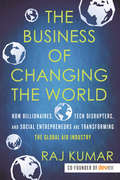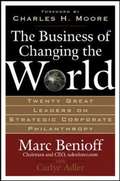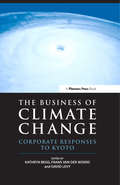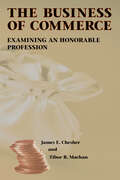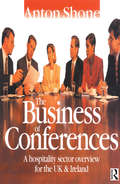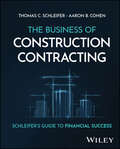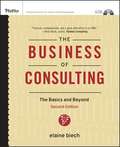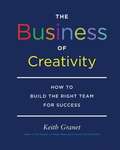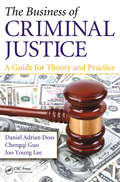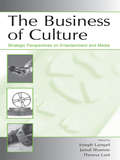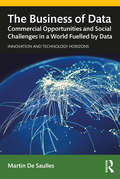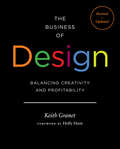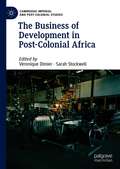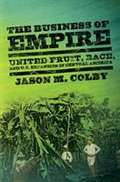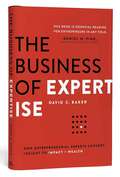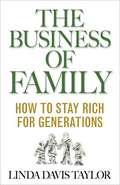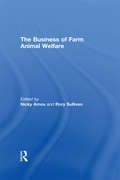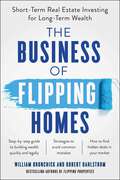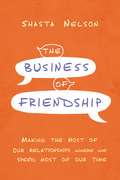- Table View
- List View
The Business of Changing the World: How Billionaires, Tech Disrupters, and Social Entrepreneurs Are Transforming the Global Aid Industry
by Raj KumarThe new world of results-driven aid that could put an end to extreme povertyDrawing on 2 decades covering global development as editor in chief of Devex, Raj Kumar explores how nontraditional models of philanthropy and aid are empowering the world's poorest people to make progress. Old aid was driven by good intentions and relied on big-budget projects from a few government aid agencies, like the World Bank and USAID. Today, corporations, Silicon Valley start-ups, and billionaire philanthropists are a disrupting force pushing global aid to be data driven and results oriented. This $200 billion industry includes emerging and established foundations like the Chan Zuckerberg Initiative and the Bill and Melinda Gates Foundation. Entrepreneurial startups like Hello Tractor, which offers an Uber-like app for farmers in Nigeria, and Give Directly, whose app allows individuals to send money straight to the phone of someone in need, are also giving rise to this new culture of charity. The result is a more sustainable philosophy of aid that elevates the voices of the world's poor as neighbors, partners, and customers.Refreshing and accessibly written, The Business of Changing the World sets forth a bold vision for how we can use our vote, our voice, and our wallet to turn well-intentioned charity into effective advocacy to transform the world for good. Businesspeople, policymakers, entrepreneurs, nonprofit executives, philanthropists, and aid workers around the world will all be influenced by this transformation.
The Business of Changing the World: Twenty Great Leaders on Strategic Corporate Philanthropy
by Marc Benioff Carlye AdlerBusiness leaders share their corporate philanthropy secrets to reveal how any company can start their own program.
The Business of Climate Change: Corporate Responses to Kyoto
by David Levy Kathryn Begg FRANS VAN DER WOERDIn recent years climate change has become a leading issue on both the business and political agenda. With the Kyoto Protocol to the UN Framework Convention on Climate Change now ratified, business is bracing itself for the reality of serious regulation on the reduction of greenhouse gas emissions.The Business of Climate Change presents a state-of-the-art analysis of corporate responses to the climate change issue. The book describes and assesses a number of recent business approaches that will help to identify effective strategies and promote the dissemination of proactive corporate practices on climate change worldwide. By identifying the factors that cause companies to pursue low-carbon strategies and support the Kyoto process, the book will also be helpful to governments in formulating policy.Business and industry have a crucial role to play in the implementation of the Kyoto Protocol. They are major emitters of greenhouse gases, and pressure is mounting for them to engage in a range of mitigation strategies, from emission inventorying and trading schemes to investments in low-carbon technologies. Behind the scenes a number of companies have started to develop strategies to curtail greenhouse gas emissions.These strategies can be very diverse in nature. At a political level, companies try to influence policy implementation and, more specifically, to test ideas in anticipation of possible regulation on the climate change issue. At a more practical level, there are a burgeoning number of initiatives to conserve energy use in production, transportation and buildings, to develop renewable sources of energy, to measure carbon emissions and sequestration at a detailed level, and to develop various markets for trading carbon credits among companies and countries. Some technologies, such as hybrid cars and compact fluorescent lighting, are now market realities.Common to all of these initiatives is that they operate in an environment of high complexity and uncertainty. The political implementation of the Kyoto Protocol remains uncertain and many details remain unspecified. Economic instruments such as emission trading are favoured, but their mechanisms are still hotly debated and the future price of credits is unknown. New markets for low-emission products and technologies are beginning to appear, but there are currently few regulatory drivers to assist their development. The impact of potential regulation on business will vary tremendously between companies and sectors. The fossil fuel and energy sectors fear the economics of action, while sectors such as insurance and agriculture fear the economics of inaction. Combined with the remaining uncertainties about what form climate change may take, corporate responses to reduce risks have to differentiate between sectors and have to be flexible. For individual companies, these big uncertainties demand new thinking and contingency planning.The Business of Climate Change is split into four sections: "Introduction and overview" presents a broad perspective on business and climate policies
The Business of Commerce: Examining an Honorable Profession
by Tibor R. Machan James E. ChesherChesher and Machan explore the cultural, philosophical, and theological sources of the bad reputation suffered by business in Western culture. They sample prominent opinion, from Plato to Galbraith, in an examination of the fundamental dichotomies of a society that seeks prosperity, yet disdains the processes by which prosperity is achieved.
The Business of Conferences
by Anton ShoneFor managers, students and conference professionals this timely new book will provide a firm foundation for understanding and operating in one of the UK's fastest growing business areas. Conferencing forms a large and expanding part of the UK economy and is now attracting serious analysis as the key techniques and principles of good practice become established. This unique book, one of the first written by an expert educator and consultant in the field, considers the background and nature of the UK conference industry and looks at the management issues involved in professional and competitive conferencing.Providing clear, up to date and detailed information on every aspect of the management and organization of conferences and conference centres it will be an essential text for students on hospitality and tourism courses- from GNVQ to undergraduate level. It will also be a vital reference for practitioners in any part of the conference business who want to grasp the key elements for success in the future.
The Business of Construction Contracting: Schleifer's Guide to Financial Success
by Thomas C. Schleifer Aaron B. CohenExplore this deep dive into the business side of construction, including how to structure, organize, and operate a construction organization to maximize profit The most visible work of construction contracting happens on the job site, but some of the most important aspects of running a construction business happen behind the scenes, on the financial and operations side. Construction is the second-most risk-intensive industry in the US, and both minimizing business failures and minimizing the damage that results from inevitable failures are critical. Structuring and managing a profitable construction business requires strategic sense and up-to-date knowledge. The Business of Construction Contracting describes and analyzes the business side of construction, with a detailed exploration of the major types of business failure and how to avoid them. It’s designed for construction professionals who understand that in this industry everybody faces risk exposure, and the companies that survive and thrive are the ones who understand how to recognize the risks and respond accordingly. It offers documented research findings, rooted in years of construction business experience, that can help both new and veteran business owners find success. The Business of Construction Contracting readers will also find: Exploration of the concepts of flexible overhead, corporate, and financial self-analysisDetailed discussion of topics including cash flow thresholds, construction market cycles, and moreThe latest industry technologies and techniques to manage a construction business The Business of Construction Contracting is ideal for construction professionals – including general contractors, construction managers, and specialty contractors – as well as bonding and insurance professionals, construction attorneys, and vendors servicing the construction industry.
The Business of Consulting
by Elaine BiechDesigned as the go-to reference for managing a consulting business, The Business of Consulting is candid, practical, and eminently useful. Fine-tuned to address the changes in today's business environment, this vital resource outlines the basics for managing a consulting practice and shows how to · Develop a business plan· Market your business· Charge for your services· Build a client relationship· Grow the business· Ensure your continued professional growth· Make money in the profession
The Business of Corporate Learning
by Shlomo Ben-HurCorporate learning functions are now an established part of many of the world's leading multinational firms. In this book, Shlomo Ben-Hur demonstrates how corporate learning can and should have an integral, strategic, role in a company. Based on firsthand experience, Ben-Hur provides a practical guide to setting up or restructuring a corporate learning function within a company, covering its seven key activities. He identifies and elucidates the key decision points in this process. But The Business of Corporate Learning is much more than a 'how-to' guide. For the first time, this book sheds light on the reasons for success or failure in the strategic deployment of corporate learning. Real-world case studies are used to illustrate the potential pitfalls and demonstrate how - when successfully integrated into the company's strategic management system - corporate learning is able to deliver tangible business results.
The Business of Creativity: How to Build the Right Team for Success
by Keith GranetLong known as the go-to management consultant of the design world, Keith Granet reveals more of his clear-eyed insights about running a creative business in this follow-up to his book The Business of Design. While aimed at creative enterprises, Granet's advice, quickly summarized as "know what you do best and focus on that," applies to any organization, small or large, commercial or nonprofit. He delves into the skill sets and people needed to grow a business, as well as the things you don't need (bad clients, bad employees, negative energy), in an engaging and easy-to-implement manner. His shrewd understanding, gleaned from decades of consulting for brands like Harrods, Pantone, John Varvatos, and Urban Archeology, makes this essential reading for anyone managing a business or thinking of starting one.
The Business of Criminal Justice: A Guide for Theory and Practice
by Daniel Adrian Doss Chengqi Guo Joo Young LeeThis book represents the manifestation of a new presentation of old perspectives within the discipline of criminal justice. It contains practical considerations of rendering such decisions, it is expected to be an appropriate reference among practitioner personnel.
The Business of Culture: Strategic Perspectives on Entertainment and Media (Organization and Management Series)
by Joseph Lampel Jamal Shamsie Theresa K. LantThe business of culture is the business of designing, producing, distributing, and marketing cultural products. Even though it gives employment to millions, and is the main business of many large and small organizations, it is an area that is rarely studied from a strategic management perspective. This book addresses this void by examining a wide range of cultural industries--motion pictures, television, music, radio, and videogames--from such a perspective. The articles included in this book will be helpful to individuals who seek a better understanding of organizations and strategies in the entertainment and media sector. But it should also provide valuable insights to managers and entrepreneurs who operate in environments that share the creative uncertainty and performance ambiguity that characterize most cultural industries.
The Business of Data: Commercial Opportunities and Social Challenges in a World Fuelled by Data (Innovation and Technology Horizons)
by Martin De SaullesThis book is about the rise of data as a driver of innovation and economic growth. It charts the evolution of business data as a valuable resource and explores some of the key business, economic and social issues surrounding the data-driven revolution we are currently going through. Readers will gain an understanding of the historical underpinnings of the data business and why the collection and use of data has been driven by commercial needs. Readers will also gain insights into the rise of the modern data-driven technology giants, their business models and the reasons for their success. Alongside this, some of the key social issues including privacy are considered and the challenges these pose to policymakers and regulators. Finally, the impact of pervasive computing and the Internet of Things (IoT) is explored in the context of the new sources of data that are being generated. This book is useful for students and practitioners wanting to better understand the origins and drivers of the current technological revolution and the key role that data plays in innovation and business success.
The Business of Design: Balancing Creativity and Profitability
by Keith GranetThe Business of Design debunks the myth that business sense and creative talent are mutually exclusive, showing design professionals that they can pursue their passion and turn a profit. For nearly thirty years, consultant Keith Granet has helped designers create successful businesses, from branding to billing and everything in between. Unlike other business books, The Business of Design is written and illustrated to speak to a visually thinking audience. The book covers all aspects of running a successful design business, including human resources, client management, product development, marketing, and licensing. This timely update on the tenth anniversary of the first edition includes new content on social media, working from home, and understanding and working with different generations, essential tools in today's ultracompetitive marketplace.
The Business of Development in Post-Colonial Africa (Cambridge Imperial and Post-Colonial Studies)
by Sarah Stockwell Véronique DimierThis collection brings together a range of case studies by both established and early career scholars to consider the nexus between business and development in post-colonial Africa. A number of contributors examine the involvement of European companies (most notably those of former colonial powers) in development in various African states at the end of empire and in the early post-colonial era. They explore how businesses were not just challenged by the new international landscape but benefited from the opportunities it offered, particularly those provided by development aid. Other contributors focus on the development agencies of the departing colonial powers to consider how far these served to promote the interests of European companies. Together these case studies constitute an important contribution to our understanding of both business and development in post-colonial Africa, redressing an imbalance in existing histories of both business and development which focus predominantly on the colonial period. This volume breaks new ground as one of the very first to bring the study of foreign companies and development aid into the same frame of analysis
The Business of Empire: United Fruit, Race, and U. S. Expansion in Central America
by Jason M. ColbyThe link between private corporations and U.S. world power has a much longer history than most people realize. Transnational firms such as the United Fruit Company represent an earlier stage of the economic and cultural globalization now taking place throughout the world. Drawing on a wide range of archival sources in the United States, Great Britain, Costa Rica, and Guatemala, Colby combines "top-down" and "bottom-up" approaches to provide new insight into the role of transnational capital, labor migration, and racial nationalism in shaping U.S. expansion into Central America and the greater Caribbean. The Business of Empire places corporate power and local context at the heart of U.S. imperial history. In the early twentieth century, U.S. influence in Central America came primarily in the form of private enterprise, above all United Fruit. Founded amid the U.S. leap into overseas empire, the company initially depended upon British West Indian laborers. When its black workforce resisted white American authority, the firm adopted a strategy of labor division by recruiting Hispanic migrants. This labor system drew the company into increased conflict with its host nations, as Central American nationalists denounced not only U.S. military interventions in the region but also American employment of black immigrants. By the 1930s, just as Washington renounced military intervention in Latin America, United Fruit pursued its own Good Neighbor Policy, which brought a reduction in its corporate colonial power and a ban on the hiring of black immigrants. The end of the company's system of labor division in turn pointed the way to the transformation of United Fruit as well as the broader U.S. empire.
The Business of Europe is Politics: Business Opportunity, Economic Nationalism and the Decaying Atlantic Alliance
by Dimitris N. ChorafasIt is no secret that Europe is currently undergoing a major economic and social crisis, so it is essential says Dimitris Chorafas that leaders of industry and finance within the EU, or doing business with the EU, know what is going on. What is it that threatens competitiveness and produces obstacles to providing a vibrant business landscape in the European Union? This book offers insight into the particular nature of the European cocktail of business and politics, explaining how that bears on trade and relations between, for example, continental Europe and the UK, across the Atlantic with the US, with Russia and with Asia. Dr Chorafas explains and critiques Europe's conflicting aims and what he describes as its wanting business plan. Case studies to illustrate the consequences for business of the deficiencies identified are included. With its mix of rigorously researched background and forthright argument, this timely book will satisfy those academics with an interest in the issues addressed and will also serve as a planning tool for business leaders and government executives trying to determine what they can do at enterprise level. The challenge is to survive and prosper in an environment where 'business is politics'.
The Business of Event Planning: Behind-the-Scenes Secrets of Successful Special Events
by Judy AllenPractical tools and expert advice for professional event planners Before planning an event, there is much that must be done behind the scenes to make the event successful. Before any thought is even given to timing or location of the event, before the menus are selected and the decor designed, there are proposals to be written, fees and contracts to be negotiated, and safety issues to be considered. This book takes you behind the scenes of event planning and explains every aspect of organizing and strategic planning. This book will be of value to both the professional event planner and to clients who are dealing with planners. Its comprehensive coverage includes: how to prepare winning proposals, and how to understand them if you are the client; how to determine management fees; negotiating contracts; safety issues; designing events in multicultural settings; and new technology that makes operations more efficient (such as online registration and response management, database project management tools). The book also includes practical tools such as sample letters of agreement, sample layouts for client proposals, forms, and checklists. Professional event planner Judy Allen offers first-time or professional event planners all the top-class advice they need to make their special events come off without a hitch.
The Business of Expertise: How Entrepreneurial Experts Convert Insight to Impact + Wealth
by David C. BakerThis passionate expertise manifesto is intended to elevate the impact of advisors who sell insight as entrepreneurs. Three foundational chapters form the basis of the entire book: experts develop insight by isolating patterns in data; they convert those insights to wealth by crafting a unique positioning for which few available substitutes exist; and their confidence grows as the marketplace embraces their application of expertise. <p><p>The next fifteen chapters--building on that foundation--each answer a single question, starting with the role of expertise in a developed society, how important it is for experts to love the hard work required to hone their expertise, and how to see all that in the context of their own purpose in the world. We pause to dig deeper by examining the very narrow overlap between expertise and entrepreneurship: the narrow slice of humanity for which this book was written, with a nod to how easy it is for those entrepreneurial experts to be pulled off mission to explore new things.
The Business of Family
by Linda Davis TaylorThe Business of Family teaches readers how to write their own family business plan using time-tested strategies from the corporate world to provide a practical, user-friendly method that ensures their family knows where it's been, where it's headed, and how it's going to get there.
The Business of Farm Animal Welfare (The Responsible Investment Series)
by Nicky Amos Rory SullivanGlobally, nearly 70 billion animals are farmed annually for meat, milk and eggs. Two-thirds of these are farmed intensively. The views held by food companies on animal stewardship, and the management practices and processes that they adopt are, therefore, of critical importance in determining the welfare of these animals. Yet, despite the scale of the food industry’s impact, farm animal welfare remains a relatively immature management issue. There is a lack of consensus around the specific responsibilities companies have for farm animal welfare, and around how companies should treat the animals in their or in their suppliers’ care. This book, The Business of Farm Animal Welfare, provides an extensive, authoritative analysis of current corporate practice on farm animal welfare. It critically reviews and assesses the ethical and business case for action. Through a series of practitioner case-studies, it describes how companies have addressed farm animal welfare in their operations and supply chains. It analyses the key barriers to companies adopting higher standards of farm animal welfare, and offers a series of practical recommendations to companies, consumers and policy makers on the role that they might play in raising farm animal welfare standards across the food industry. As the first comprehensive account of business and farm animal welfare, this book is an essential resource for researchers, practitioners and general readers looking to understand and influence corporate practice on farm animal welfare.
The Business of Fashion: Designing, Manufacturing, And Marketing
by Leslie Davis Burns Kathy K. Mullet Nancy O. BryantLearn how fashions lines are designed, manufactured, marketed, and distributed. The book covers the full supply chain - from textiles to fashion brand production to retailing - as well as supply chain management, and competitive strategies, so that you can be successful in your future career. Topics covered include sustainable design for a circular economy, 3-D printing, fashion entrepreneurship, disruptions in fashion calendars, supply chain transparency, impact of social media, growth and evolution of online retailing, expanded omnichannel strategies, and changes in international trade, among others. Case studies, a Career Glossary, and key terms help you connect concepts to practice.
The Business of Fine Art Photography: Art Markets, Galleries, Museums, Grant Writing, Conceiving and Marketing Your Work Globally
by Thomas WernerThis guide for aspiring and exhibiting photographers alike combines practice and concept to provide a roadmap to navigating, and succeeding in, the fine art photography marketplace locally, domestically, and internationally. Join former New York gallery owner, international curator, and fine art photographer Thomas Werner as he shares his experiences and insights from leading curators, gallerists, collectors, auctioneers, exhibiting photographic artists, and more. Learn how to identify realistic goals, maximize results, work with galleries and museums, write grants, develop strong nuanced imagery, and build a professional practice in a continually evolving field. Featuring dozens of photographs from international practitioners, and a robust set of resources, this book will ensure you have the tools to give you the opportunity for success in any marketplace. Whether you are a student, aspiring photographic or video artist, or a photographer changing careers, The Business of Fine Art Photography is your guide to starting and growing your own practice.
The Business of Flipping Homes: Short-Term Real Estate Investing for Long-Term Wealth
by William Bronchick Robert DahlstromWhether you're looking to make a career out of flipping homes or see it as a part-time venture, you can make fast money legitimately. Before you get started, you need to know the right way to flip, regardless of local market conditions and current economic trends. There's more to flipping than redoing a kitchen or staging a property. Every deal is different, and each investor must have a clear business strategy. Expert investors William Bronchick and Robert Dahlstrom have learned how to be successful in all types of markets—and now they share their secrets with you. From the bestselling authors of Flipping Properties, which brought the term "flipping" to American households, The Business of Flipping Homes is an A-to-Z guide for both new and seasoned investors. The book explains what flipping is and isn't, goes beyond the investment of a basic single-family home, and demonstrates how to find, renovate, and sell properties using proven methods. With more than 40 years combined experience in buying and selling investment properties, Bronchick and Dahlstrom explain how to avoid many of the pitfalls and issues that could drain your funds and come back to haunt you. They give systematic approaches on long-term planning, including how to find and work with partners, structure a business, and utilize your specific talents, resources, and aspirations in realistic ways. You'll learn how to figure out timelines, work with real-estate agents, understand the paperwork, analyze the numbers, utilize technology, and, most important, find the money.
The Business of Friendship: Making the Most of Our Relationships Where We Spend Most of Our Time
by Shasta NelsonWant to be happier, healthier, and enjoy your job more?Make better friends at work.The data is in. It is virtually impossible to feel connected and supported in life when we don&’t feel that way where we spend most of our time—at work. Whether we work remotely or in an office, who we interact with consistently impacts everything from our longevity and mental health to our career success and job satisfaction.Unfortunately, too many of us don&’t feel like we belong at work in the ways we need. In addition to the 20% of us who report feeling lonely at work almost all the time, 60% of us report feeling it at least half the time., and that disconnection is taking a toll: more stress and burnout, less energy, decreased loyalty to our company, and increased dread for &“Monday morning.&”In The Business of Friendship, Shasta Nelson, a friendship expert, unpacks the distinct ways we can make work relationships the healthiest they can be, both for the sake of the employee and the mission of the company. She inspires readers to see why friendship is crucial to our health and our careers and teaches us exactly how to develop the supportive and meaningful connections we need.Our organizations benefit as well when our leaders encourage friendships at work. The outcome is higher levels of workplace productivity, employee retention, safety, innovation, collaboration, and profitability. In fact, having a best friend at work we are seven times more engaged in our job, which translates to better customer service, less absenteeism, fewer workplace accidents, and more loyalty to our organizations. The best employees are the ones who feel connected.Work is to adults as school is to kids—a consistent place with familiar people. But too few of us are taking advantage of this environment. This leaves us no other choice but to try to get all our relational needs met in our off-work hours, where most of us already report feeling &“too busy.&” The result? We stay lonely, wishing for more meaningful connections.Through Shasta&’s stories, research, and practical guidance, sheBreaks down what creates healthy bonds and reveals the 3 requirements necessary in all healthy relationships and teamsHelps managers and employees assess the health of their relationships and learn ways to repair and improve themProvides advice for addressing some of the biggest fears around workplace friendships, such as increased drama, favoritism, confidentiality, gossip, toxic coworkers, relationship with bosses, and potential romantic attractionsThe Business of Friendship is for those who are ready to maximize the two most significant factors of our wellbeing—career and relationships. Whether you are a leader or an employee, when you feel more connected and supported at work, everyone wins.
The Business of Gamification: A Critical Analysis (Routledge Advances in Management and Business Studies)
by Peter Zackariasson Mikolaj DymekAt the turn of the century the term "gamification" was introduced as a concept to understand the process of using game mechanics in "non-game" contexts. The impact of gamification was soon evident to business practices where it had impact both on marketing and, more broadly, on the organizations themselves. As the number of individuals playing video games grows, there seem to be an acceptance of game mechanics elsewhere. Its effectiveness is highly dependent on both technical possibilities and cultural acceptance, two factors present today. The aim of The Business of Gamification is to critically analyze the practical and theoretical consequences of gamification. Practically, how has gamification been applied in businesses to this point, and what are the future scenarios? Theoretically, what are the contributions of gamification to existing academic knowledge? How does this change our understanding of how business are performing and its consequences, for organizations, consumers, and society in general? This edited volume contains new, and stringent, perspectives on how gamification is contextualized in business settings, both in theory as well as in practice. This book will provide a wealth of research for individuals seriously interested in the industry at the academic level. As a result, this book will serve as a reference in curricula associated with video game development for years to come.
